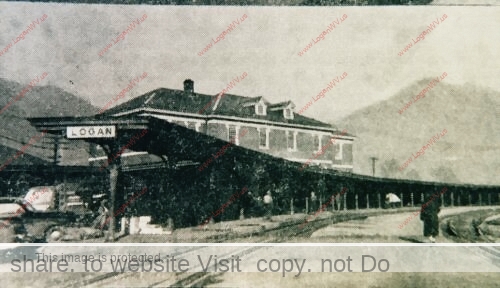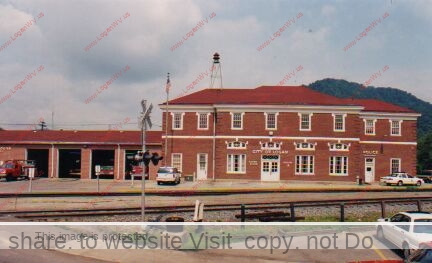This was originally published on Martha Sparks’ My West Virginia Mountain website and is reprinted here with her permission and our special thanks.
 Construction on the C&O railway first moved eastward in 1872 toward Charleston, West Virginia, running a route through Teays Valley. When the railroad began its line, the Guyan River had provided obstacles that slowed the progress. A bridge had to be built across the river so the railroad could move eastward. The small steamboats and pushboats were the only means of travel between Guyandotte and Chapmanville. During the high water season, boats were able to travel on to Logan. This was the only means of transportation except for the narrow trails that could only be traveled by horse.
Construction on the C&O railway first moved eastward in 1872 toward Charleston, West Virginia, running a route through Teays Valley. When the railroad began its line, the Guyan River had provided obstacles that slowed the progress. A bridge had to be built across the river so the railroad could move eastward. The small steamboats and pushboats were the only means of travel between Guyandotte and Chapmanville. During the high water season, boats were able to travel on to Logan. This was the only means of transportation except for the narrow trails that could only be traveled by horse.
A need existed for a railroad line to be built up the river to Logan. The Guyan Valley Railroad was granted the charter in March 1, 1899, to construct a rail line from Barboursville up the Guyandotte River to Logan. Plans and surveys were taken but construction did not begin until spring of 1900. The work crew completed 25 miles of rail line to Midkiff, the first two years.
In December 1901, the Guyan Valley Line instituted its first round trip passenger train. A person could now take the train to Midkiff. They would then have to transfer to the steamboats for the journey to Chapmanville and then to Logan.
Looking for ways to expand its capital in the form of other rail lines, the C&O entered the picture in April 1902 to take over construction of the line to Logan. With the C&O offsetting construction costs, the line continued on toward Logan. The C&O finally took over the Guyan Valley Railroad Company on October 31, 1903. Construction moved southward along with train service and in November 1903, the passenger train began making round trips to Big Creek. With the arrival of the railroad, the small steamboats and pushboats soon went out of business.
The first passenger train reached to the town of Logan on September 9, 1904. This was a great day for Logan and Logan county because the railroad linked the two with the outside world. The people of Logan appreciated the railroad completion and a gala celebration was given in honor of the railroad.
With the rail link completed to Logan, many people needed transportation so they could find jobs in the coal mines that were opening. In November 1904, the C&O provided two eastbound and westbound passenger trains that departed from Barboursville at 6:05 a.m. and 4:15 p.m. opposite a 5:00 a.m. and 10:00 a.m. departure from Logan. The population of Logan and surrounding areas grew in large numbers as the passenger trains were filled to capacity.
The economy of the area around Logan increased with the completion of the line. The first car of coal was shipped Thanksgiving Day 1904 by the Gay Coal & Coke Company.
During the heyday of passenger service, seven regular trains made daily runs throughout the county.
 Logan, WV City Hall and old Train Station
Logan, WV City Hall and old Train Station

When was the train trussel spanning the Guyandotte in Logan completed?
In Wib G. Whited’s article in the 1952 Centennial Program Booklet describing the Logan County railroad history of 1904, he wrote:
“….. In the meantime, the railroad bridge across the Guyan River was being built jointly with the United States Coal and Oil Company now know(sic) as Island Creek Coal Company…”
Does anyone remember “Red Top Inn” which was at the train station at Peach Creek – the man who owned/operated was my grandfather Kelly Cox
Thank you Faye
The Logan Train Station
The Chesapeake & Ohio Historical Society (hereinafter “C&O archives”) is a source of C&O railroad information (see website: http://archives.cohs.org/). The organization has its railroad museum in Clifton Forge, Virginia. The “C&O archives” in their “drawings” files under their KEYWORDS listing for “passenger station Logan” has a design drawing #BL-2041-1 titled: “Design for Passenger Station Logan,W. Va. Guyandot Valley Ry. July 13, 1904”. There also is a drawing #BL-2041-2 which is a materials specification list for the building. Photo #295 in the Logan main photo gallery on this website is that building.
It is worth noting that the design of the Logan (and Man) depots did not include the fancy woodwork trim that earlier C&O stations had. Apparently, C&O abandoned use of the fancy woodwork in the early 1900’s after using it for decades in early stations. The fancy woodwork was on the end gables of the buildings and covered the protruding beams that supported the overhanging roof ends. The fancy woodwork was a Victorian-age style of lattice-work boards with an inverted semi-circle pattern. C&O called the trim “vergeboard” and such fancy trim is often referred to as “gingerbread” trim. The “C&O archives” in their “photo” files under their ARCHIVE NUMBER listing of “3038” shows the C&O station at Nuttall, WV as an example of this fancy woodwork.
The “C&O archives” files under their KEYWORDS listing for “privy” has a design drawing #std-sc-64 for a standard privy. I assume there was one built at the Logan station in 1904.
The book “A History of The City of Logan, W. VA. 1823-1916” by George T. Swain (hereinafter “Swain’s book”) is a very good searchable external website linked to the topic “History of Logan County” on this website. It is noteworthy that Swain’s book (pg. 41) has this comment about a Logan City Council meeting: “…At regular meeting held May 14, 1916, on motion the following resolution was adopted and the City Attorney and Recorder were to take up the matter with the Public Service Commission of the State: Whereas, our Health Officer, Dr. McDonald, has on many occasions in his reports condemned the present depot of the C&O Railway and reported that sanitary conditions are irreparable, that the rooms are inadequate in size, that no janitor is employed to care for the sanitary keeping of this depot, and that the men’s toilet has had to be kept under lock and key by reason of no janitor. Whereas, the Logan station is shown by the C&O annual report to be over $600,000 above any other station on its system and conveniences are nil compared with its importance. That the officials have delayed from time to time any plans for the improvement of present conditions. That the sanitary conditions are fearful and dangerous to the public health and the present depot is inadequate and cannot be made efficient as the said health officer sets forth, therefore, Be it resolved, That the Public Service Commission be and is hereby requested to make an immediate investigation and require the C&O Railway Co. to give the city the conveniences necessary for the care of the public commensurate quarters with the sanitary conveniences necessary and janitor to maintain and keep same.”
Swain’s book (pg 89) further addresses the original train station’s inadequacy compared to its huge financial success thusly: “….And in taking comparison of the poor little chicken coop of a station situated here, we feel that their situation is amply justified. ……The passenger station at the present time being a little dirty cramped affiar, consisting of nothing more than a small room for the selling of tickets and two small spaces called waiting rooms…”
The new station was finally built in 1921.
Swain’s book (page 109) discussing the C&O railroad states: “…The first train to reach Logan came in on the 9th day of September, 1904, being a local freight consisting of engine No. 174 and four cars, containing two cars of feed, one care of household goods and one car of coal. Neal Parsons was the man at the throttle while C.J. Southworth was the conductor in charge….” Perhaps erroneously, the Martha Sparks article states that the first train was a passenger train.
I remember boarding the passenger train at Lorado in the early ’40’s destination ,,Huntington WV. Me ,mom and my younger sister Polly ,,,
I remember riding the train from Pecks Mill to Logan with my mother when I was a kid in the 1950s. Larry Lowe
What year did they shut down the train depot?
Passenger service was discontinued in 1959. C & O Railway donated the depot buildings to the city in April of 1965.
I remember riding the train to bigcreek to visit. Did not it run to Man or was that just the mail train. I saw people board the train at Stollings. The train stopped there to drop mail. A person by the name of Ivan delivered the mail to the Stollings po.
The passenger train went as far as West Gibert. There is where the C&O RR joins the Virginian RR. Only one trip per day for this run ; however,another train was added which went as far as Logan later on. I rode the train to West Gibert several times as a young kid
Shelby B.